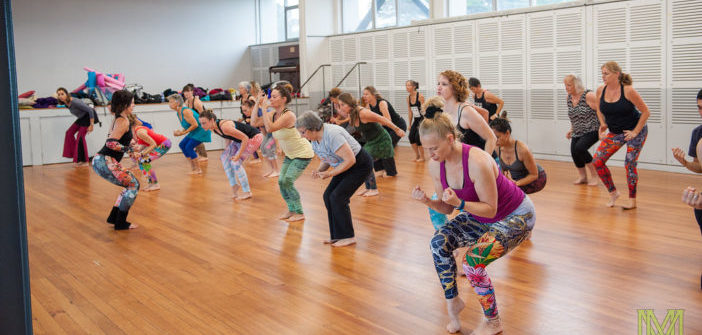I’ve written about the instances when I met awesome people during my travels, and it’s amazing to think that those experiences lead to many new exciting ones in which I’m able to improve my abilities.
Such an experience was joining an aerobic workout inspired by dance, meditation, and martial arts. The “Nia Technique” might sound new to many of us here in Beijing, but it’s a fitness program developed in the 1980s which evolved to include practices that benefit the mind.
I first heard of Nia during a trip in 2016 when I met a practitioner on the Trans-Siberian Railway. While en route to Moscow, Jinti Wight-Boycott told me about their dance-meditation exercise on the Great Wall. That intrigued me because of the inclusion of several Chinese martial art maneuvers along with the graceful dance gestures and relaxing breathing exercises. I met Jinti and her husband Andy on a separate trip last year, during which she gave me the contact of Polly Gough-Olaya, a Nia practitioner in Beijing. I wasn’t able to get in touch with her until last month, when I saw a class poster on WeChat. So I quickly contacted her and arranged to join a session.
If there’s one performing art that I wish I was able to do just right, that would be dancing. So joining a Nia class was definitely a challenge because of my near-aversion towards dancing and its associated movements; but its other elements, the healing arts and the martial arts, completely piqued my interest because of my inclination to mindfulness practices and culture.
Gough-Olaya welcomed me with a big grin and it felt like we had known each other for a long time! We held a one-on-one session during Diwali and blasted Indian harmonies through the entire studio. That helped us fly away in the rhythms — which, for me, was a truly liberating experience. For some, classes like this are seen as more “feminine”, but I didn’t really mind anyway, especially as it’s a chance to feel relieved of stress while pumping those thigh muscles up.

“It is so hard to describe Nia, yet taking part in a Nia class, it is very easy to understand the benefits that come with such a practice. Nia is, at its very simple core, a cardio workout. But cardio (dance) combined with martial arts and healing arts means that Nia offers much much more than just a simple fitness class,” Gough-Olaya explained.
Nia routines take inspiration from three different interconnected forms, each having three concepts: the martial arts comprised of tai chi, tae kwon do and aikido; the dance arts using jazz, modern, and Duncan Dance moves; and the healing arts that focus on the mind and self-awareness: Feldenkrais, Alexander Technique, and yoga. Practitioners around the world say this workout energizes the body, mind, and spirit, in a way that it allows one to build strength, aerobic fitness, and flexibility while following their body’s natural way.
Gough-Olaya took her first Nia class four years ago, and since then, she has loved doing it, so much so that she became a Nia teacher. The Nia community in Beijing is mainly women, though she says there are many men who enjoy classes in other parts of the world. “I strongly believe that men who get involved in activities which are typically seen as more feminine find that the act of ‘letting go’ allows them to enjoy themselves more in life in general, and they are able to build a different style of mental strength which lets them see beyond gender stereotypes.”
What I particularly liked in the session is the martial arts part because you have to balance your body while transitioning from graceful gestures and twists to strong punches and kicks. My body was satisfyingly sore and stretched out toward the end of the session. This new routine was a relaxing take to my usual gym workouts wherein I often think about the physical gains and progress.
Amid the relentless pace of life in the world today, Gough-Olaya believes it’s important to do activities that help us let loose and think of the “here and now.”
“Letting go of others’ beliefs and exploring what you enjoy, even if it’s just for an hour at a time, can help you find your own voice and create mental clarity and stability,” she said.
For those interested in trying out this workout program, you can contact Gough-Olaya on WeChat (ID: pollygo). The classes take place at the second-floor dance studio in the clubhouse of the East Lake Villas in Dongzhimen (35 Dongzhimenwai Dajie) every Tuesday and Thursday evenings at 6.15-7.15pm and Thursday, Friday, and Saturday mornings at 10.30am. No sign-up is needed, and participants pay a RMB 100 fee per drop in.

Photos: Stephanie Demay via Flickr (1, 2), poster courtesy of Polly Gough-Olaya
